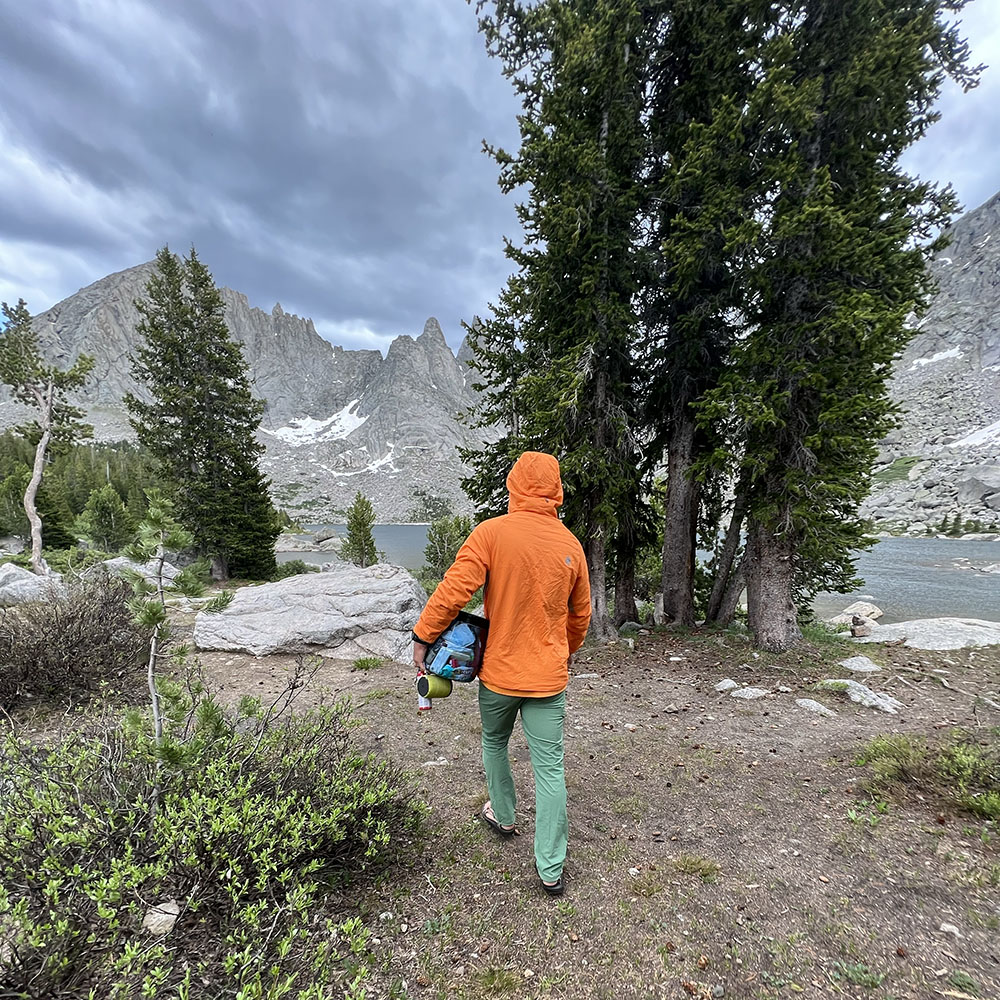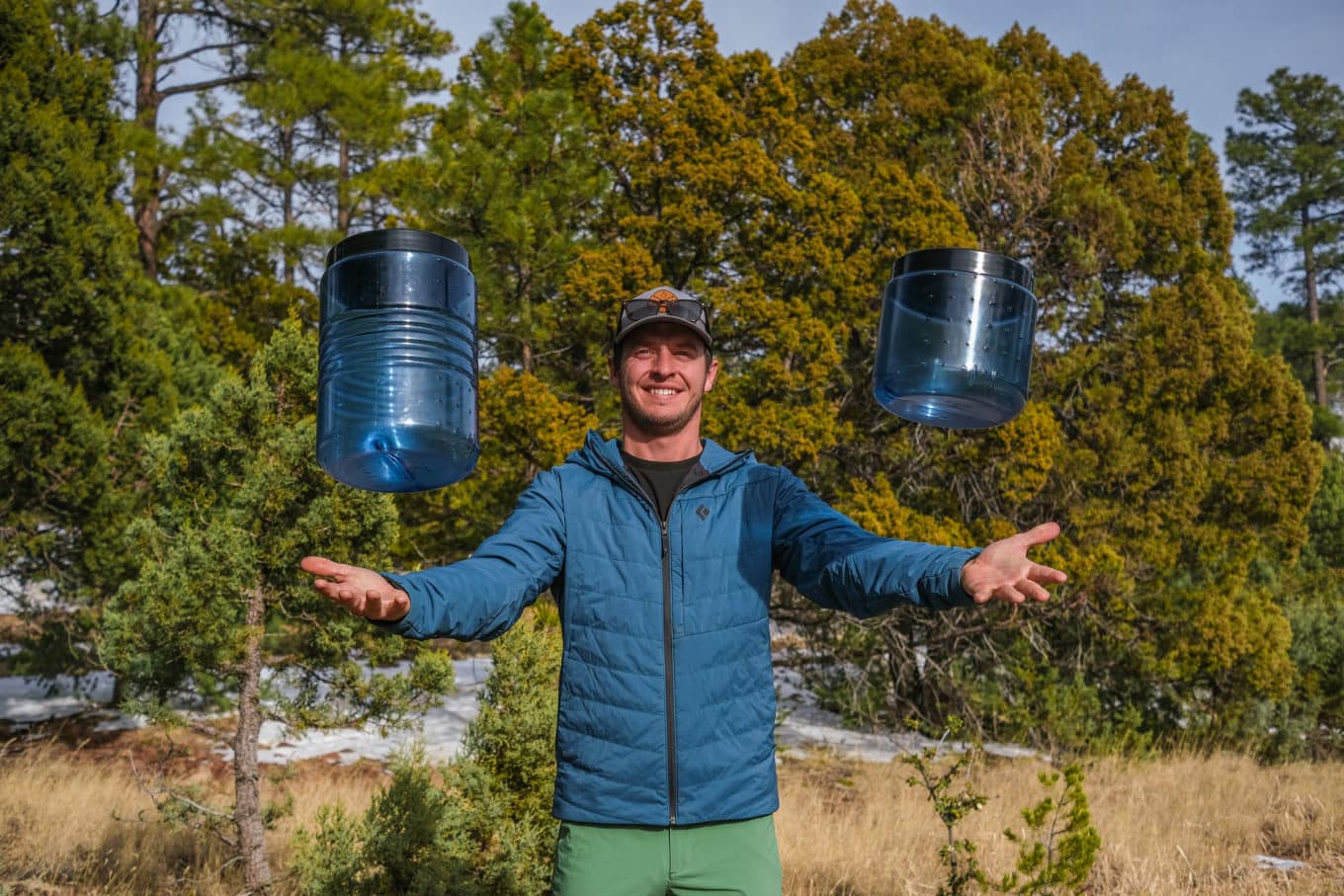So you’re starting to plan for an epic adventure, and you’ve realized you need a bear canister! The next step is to determine what size bear canister you need. We love having a variety of sizes to choose from, as we are frequenting bear country so many times every year. Each of BearVault’s four sizes has a place in our gear closet, for anywhere from a long day climbing to a multi-week trip. Making sure you have the right size for your next adventure is crucial for ensuring you have plenty of space for all of your snacks, but aren’t carrying more bulk than necessary (we all like saving weight when we can!).
BearVault carries four options for sizes of bear canisters: the BV425-Sprint (5 L), BV450-Jaunt (7.2 L), BV475-Trek (9.3 L) and the BV500-Journey (11.5 L). These four sizes are used for adventures varying from long-day adventures to 2-night backpacking trips to thru-hiking from Mexico to Canada.

Adding in the two new sizes (BV425-Sprint and BV475-Trek) was a huge step forward for BearVault in really being able to provide a size for any adventurer:
- BV425-Sprint: A 5 L canister best suited for 1-2 day adventures. This opens up a unique opportunity to carry a bear canister even on day trips, which can be really beneficial for climbers leaving their gear and food at the base of the wall or for fishermen in the backcountry out for the day. The Sprint is also great for solo backpackers on an overnight trip to keep a light pack and move fast!
- BV450-Jaunt: A 7.2 L canister best suited for 3-4 day trips. This canister has plenty of room for one person on a long weekend trip or two people on a 2 day trip.
- BV475-Trek: A 9.3 L canister ready for of ultra-lighters who are pros at packing food for longer trips as well as 5-6 day trips for one person, or for two people on a 2-3 day trip.
- BV500-Journey: The largest canister offered and able to carry 11.5 L. The Journey is best for 7+ day trips and is often the choice of thru-hikers who can re-supply for even longer trips. We typically bring a BV500 for the two of us on a 3-4 day trip!
Each of these canisters are the same diameter (8.7 inches) and vary in their heights (the BV425-Sprint is 6 inches tall, and the BV500-Journey is 12.7 inches tall). We find they all fit into most overnight backpacks vertically. Additionally, the BV425-Sprint, BV450-Jaunt, and BV475-Trek slip into most packs horizontally.
Deciding which size you need will be based on numerous factors including trip length, if you’re sharing it with another person, types of food and smellables you bring, and anything extra that may need to fit inside. Let’s start with the basics, and go from there
How many days of food fit into a bear canister?

A general rule of thumb is that one day’s worth of food takes up about 100 cubic inches or 1.6L. A BV425 can typically fit about 2 days of food and smellables for one person, a BV450 can fit about 4, a BV475 can fit up to 6 days, and a BV500 fits up to 7 or more days. Now, we’ll give you a heads up, this can vary A LOT. We all eat vastly different amounts of and types of foods. If you’re chef-ing it up at camp and plan to bring an entire charcuterie assortment (we’re with you there!), you will likely need a lot more space than your partner who lives for an entire week strictly on homemade freeze-dried meals and energy bars.
From our personal experience, here are a few different scenarios and what we’d bring:
BV425-Sprint.
One BV500-Journey OR two BV450-Jaunts
One BV500-Journey and One BV475-Trek
Either 3 BV450-Jaunts OR one BV500-Journey and one BV450-Jaunt.

The difficulty and mileage of a hike makes a huge difference in how much food needs to be packed, and two night trips can look vastly different based on calories needed and expended. Plus, each of us has very different caloric needs on a trip like this, and that all needs to be taken into account.
Backpacking is all about finding ways to split weight amongst your hiking partners, and the canisters play a big part in this. Something we’ve found to be really beneficial is the ability to bring two different sizes of canisters to divy up weight. If, on a 3 day trip, one of us carries the majority of the food in the BV500-Journey, the other can carry a BV425-Sprint or BV450-Jaunt with the excess food, and then take on some extra weight by opting to carry the stove, tent, and/or cookware.
There are many ways to choose foods that pack easily or to alter the packaging we will talk about further down. BUT there are also a few other things to think about besides just what food you will be bringing!
What else needs to go in a bear canister besides food?

ANYTHING that has a scent. Bears are thought to have the best sense of smell in the animal kingdom. It is estimated that a black bear can smell a food source from over a mile away (a polar bear has been estimated to follow seals for up to 40 miles!). Amazing, isn’t it?! In order to protect bears from our food, it’s important to ensure anything that has a scent is packed into the canister. Bears will be attracted to your food, but also anything else you may bring that smells!
This includes:
- Toiletries (toothpaste, scented wipes)
- sunscreen
- chapstick
- maybe a spoon that hasn’t been cleaned
- all trash!
We cannot stress enough how important it is that you do a sweep of your packs every evening when you get to camp (and then check one more time). The bear canisters do a great job at keeping your food and yourself safe, but accidentally leaving your sunscreen or a bar in your hip pocket from your hike could make the difference between the bears leaving your campsite alone and coming by to browse while you’re asleep.
If you happen to be bringing an animal friend along on the trip, all of their food needs to fit in the canister too. A large dog’s food can take up nearly the amount of space yours will. This can often be split up between hiking partners (if they are so kind), but can greatly impact the amount of your own food you can fit in a canister and is a big factor to prepare for.
Make sure you pre-pack everything (while you’re at home) that needs to fit in the canister on the first night to ensure it fits!
How can I fit more food in a bear canister?

Choose calorie dense foods. Food like nuts, nut butters, some energy bars, and dehydrated meals are often high calorie foods that take up little space per calorie. On the opposite side, popcorn, bread, fresh fruits, and chips take up a lot more space and hold way fewer calories and therefore, energy. Higher calorie foods will take up less canister space, weigh less per calorie, and also give you more energy for your trip.
Repackage foods. Many dehydrated meals come in packaging that you can pour boiling water directly into, to cook and eat out of. While these bags can come in super handy on the trail, they also take up a lot of extra space in your canister. If you are hurting for space, or hoping to fit into a smaller canister, putting the contents of these meals into a smaller zip-lock bag can save a ton of space (pictured to the left)! Another option is to use a needle to poke a hole in the bag to squeeze out any extra air.
Pack toiletries wisely. Being on the trail really makes you choose which toiletries are totally necessary. This rings especially true when you’re choosing between the extra wipes and a snickers bar for summit day! Each smell-able item has to go into the canister, so take that into consideration when packing. Typically, we bring toothpaste, a toothbrush, a small sunscreen and chapstick, and a small travel size bag of wipes. Thankfully these can all fit between the nooks and crannies of our harder items, and can usually squeeze in. If you’re wanting to bring moisturizers or lotions, a great hack is to use a contacts case and fill both trays with your products. It keeps them from leaking and you only have to bring as much as you’ll use.
If you’re bringing a dog, look into freeze dried food for them too! It will require you to have access to water, and it is likely more costly, but the space and weight savings may be worth it (and you can repackage these too!).
Don’t pack the first day’s food into the canister. If you are planning to hike all day, and you know you’ll be with your backpack the entire time, there is no need to fit your first day’s worth of food into the canister. You will want easy access to this food anyways while you’re hiking, and it will all be eaten by the time you go to put your bear canister in its place for the night. Just remember that you may need to pack any leftovers, and you will need enough space for all of the trash!
Make your own meals! This can be a little intimidating at first, but I promise it’s not as difficult as it seems! We picked up a dehydrator and started experimenting with simple meals we can make at home. Tacos, pastas, and ramens are a great way to get some veggies in, adjust portions to how much you actually prefer to eat, and be able to change flavors so you know you’ll love the meal! It’s also a great way to conserve space in any size of canister, as we package them into freezer ziplock bags and they take up far less space than any pre-made meals on the market.
What size bear canister do I need?
Now that you understand the different sizes, what needs to fit into your bear canister, and how to pack a little lighter, we have created a flowchart to help you make the final decision!
As we explained before, the “packability of smellables” can vary a lot! This chart would consider you “ultralight” if you are repackaging your meals into ziplock bags, carrying calorie dense bars and snacks, and are bringing the bare minimum for toiletries (small toothpaste, chapstick, toothbrush). On the other hand, I’d recommend opting for the “bulky” option if you are packing more specialty or fresh foods, have a strenuous trip planned with a lot of calories needed, are bringing a dog along, and/or are bringing some extra toiletries.

How do you pack a bear canister into a backpack?
There are a few common ways people pack the canisters, and it often depends on personal comfort, the backpack you are bringing, and how much other gear you have. The main goal with packing your canister is making sure it will be comfortable for hiking long distances, it stays centered on your back, and the pack feels balanced.


Here are the 3 most common ways to pack a bear canister:
Inside the backpack: Nine times out of ten, we prefer to pack our canisters inside our packs. We use Osprey 65L packs for most of our trips, and all four canisters fit perfectly into the pack vertically. Packing the canister inside the pack allows for it to always be full of food and reduces the need for unpacking and repacking the canister each time you camp. We always place the canister at the base of the pack, on top of the sleeping bag compartment, and pack other soft items around it to keep it centered. This keeps the canister (and its weight) centered on our backs, which helps for being comfortable while hiking.
Strapped to the top of the pack: There are a few ways to do this depending on your pack, but many backpackers prefer to keep the canister out of the backpack (especially if you’re using the BV475-Trek or BV500-Journey). Strapping it to the top can be done with the “brain” of the pack, a bungee cord or a Y-strap. Often, the canister will be emptied into your pack, as the weight near the top of the pack can throw you off balance when hiking on an incline/decline.
Strapped to the bottom of the pack: This is the least preferred way of packing a bear canister. However, if your pack has sleeping bag straps on the base of the pack, you may be able to fit the canister into these to carry it underneath the pack. Be prepared that this may be in the way when you set your pack down to take a break!
Overall, packing your canister depends on what will be most comfortable for you! We highly recommend testing each option out before your hike to determine what will be easiest, require the least adjusting, and feel right for your pack.

Picking which size you need for your trips depends on numerous factors, and will likely be unique to each adventurer! We definitely love backpacking with some extra comfort, so we typically will opt for a larger size to accommodate for extra snacks, any trash we pick up on the trail, and just not having to stress about ensuring it all fits. Generally speaking, if you’re looking at doing shorter 1-3 night trips, a BV425-Sprint or BV450-Jaunt should be sufficient for your needs! If you are hoping to do some longer treks, thru-hikes, or to share a canister with a hiking partner, a BV500 will guarantee you have plenty of room and plenty of snacks!
Still have questions, or need help figuring out which canister is best for your next adventure? BearVault is always happy to help you out. Feel free to connect with Adventure Addicts as well! You can follow along with our adventures on Instagram at @the_adventureaddicts and our blog.

Guest Author:
Adventure Addicts
Hey! We are Kelby and Zoe: two adventure addicted, outdoor loving, adrenaline seeking, gear junkies. We are on a mission to inspire more people to get outside, provide them with quality gear reviews and recommendations, and show them why we have fallen in love with the outdoors!
We spend all of our free time backpacking, hiking, mountain biking, climbing, or trying to find ways to combine all of the above. We absolutely love BearVault and are excited to be helping with some informational content regarding bear canister use and conservation! You can follow along with our adventures on Instagram at @the_adventureaddicts and our blog www.theadventureaddicts.com!




